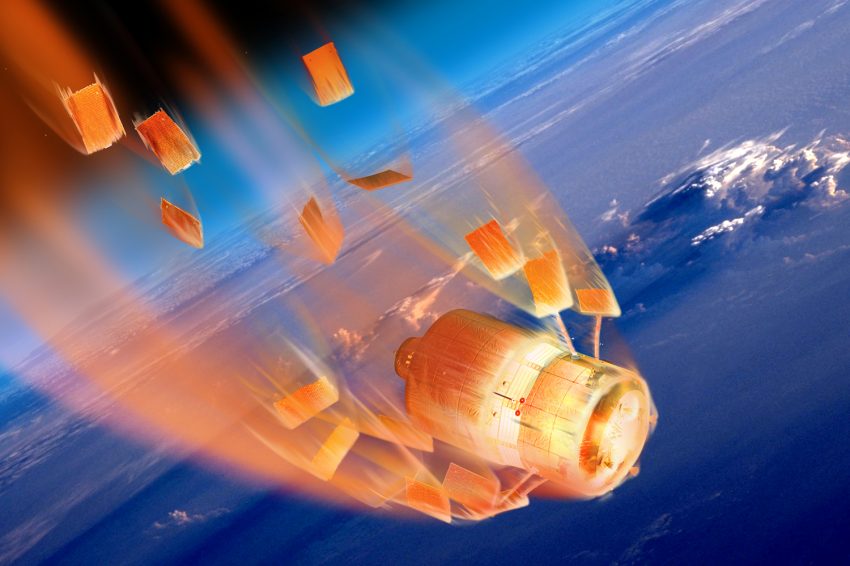Impacts of space travel on the environment and climate A boost for research: How do rocket emissions and space debris affect the Earth's atmosphere?
Rocket emissions, as well as debris from decommissioned satellites that burn up on re-entry into the atmosphere, can have a detrimental effect on the Earth’s atmosphere. “The growing scale and pace of space activity can lead to new unforeseen impacts on the environment and climate,” says Professor Karl-Heinz Glaßmeier, former head of the Space Physics and Space Sensorics Research Group at the Institute of Geophysics and Extraterrestrial Physics (IGEP) at Technische Universität Braunschweig. Research urgently needs to be intensified to understand and quantify the impact of space travel on the atmosphere.

End of a mission: ESA’s unmanned Automated Transfer Vehicle (ATV), which had been transporting supplies to the International Space Station (ISS), burns up during its controlled re-entry into the Earth’s atmosphere. Photo credit: ESA
Space travel is booming. Year after year, more and more objects are launched into space. Once they have reached the end of their lives, however, they do not disappear into the infinite expanse. Particles and gases from rocket bodies and satellite debris enter all layers of the atmosphere after re-entry – including the stratosphere with its ozone layer that protects the Earth from UV radiation. “The effects are no longer negligible,” says Glaßmeier. Together with Leonard Schulz, a research associate at IGEP, he has quantitatively investigated the mass, composition and ablation of the incoming matter in a study published in the scientific journal “Advances in Space Research”.
Human-induced input of material into the atmosphere is increasing
It is true that most of the matter in the atmosphere is of natural origin: it comes from meteors that burn up in the denser layers. Around 34 tonnes of cosmic material reach the Earth every day. “Currently, man-made input of material accounts for about three per cent of the annually injected mass of natural origin,” says Schulz. However, with the space launch rate expected to quadruple in the next four years, the researchers expect the proportion of man-made material entering the Earth’s atmosphere to increase – with as yet unknown consequences for our atmosphere and global climate.
In their study, the two scientists used models to consider two different future scenarios. Taking into account planned and already partially installed mega-satellite constellations, the man-made input of material increases to nearly 13 and 40 per cent respectively. “The man-made input of some metals already far outweighs the input from natural sources,” says Schulz.
Methods needed to quantify impacts
Satellites are made of metals, especially aluminium. Aluminium particles from burnt-up satellites can pass from the mesosphere at an altitude of 50 to 85 kilometres into the stratospheric layer below, where they promote ozone depletion as a result of chemical reactions. Nitrogen oxide and soot emissions from rocket engines also contribute to ozone depletion, as do shock waves generated by the re-entry of space debris.
The researchers still have to close important gaps in our knowledge about the extent to which rocket emissions and space debris influence atmospheric physics and chemistry. Among other things, this requires data on the materials used in launch vehicles and satellites. Schulz and Glaßmeier therefore advocate developing methods to better understand, quantify and assess the impact of space travel on the atmosphere.
There is no time to lose, as both scientists emphasise: “Targeted research is needed now to create the political and legal framework conditions that will make successful, sustainable space travel possible”. Because space travel – despite the challenges for science in particular – provides many valuable insights. Not least, satellites can be used to better observe and research climate changes on Earth.
Space Physics and Space Sensorics at IGEP
The research group Space Physics and Space Sensorics of the IGEP, headed by Professor Dr. Ferdinand Plaschke, is concerned with researching physical processes in the solar system, in particular with questions of the interaction between the solar wind plasma and planetary bodies. Planetary bodies considered here are planets and their moons as well as asteroids and comets.
